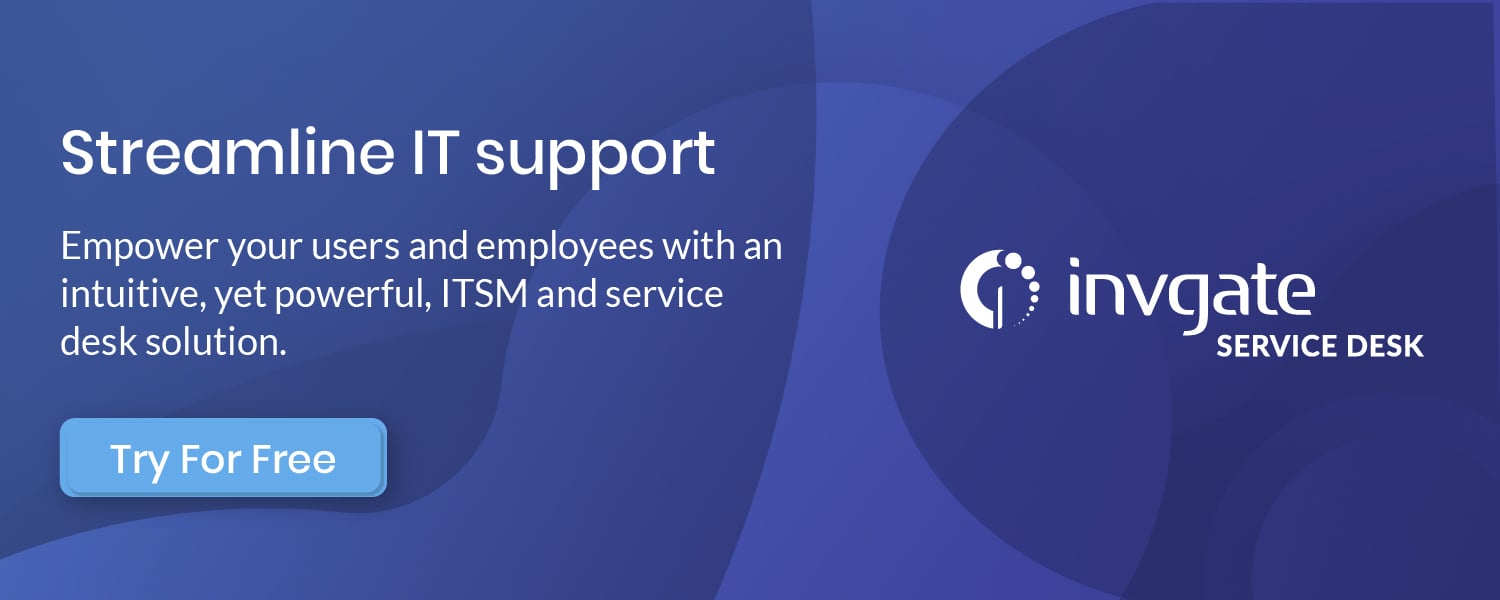The help desk is one of the most crucial elements of IT service delivery in an organization. If employees or customers face any difficulty, they're the first point of contact to resolve the issue. So, having a secure service desk is a basic step to ensure its efficiency — and avoid costly downtimes.
Besides preventing cyber attacks, a robust help desk software on your side will help you to be compliant with industry standards, so it's a win-win situation.
In this article, we'll quickly explore what a secure service desk entails, and focus on nine ways to make it happen.
Let's dig in!
Why do you need to secure your service desk?
In every organization, the service desk is the interface between the information technology teams delivering the services and the end-users using them. In addition, it tends to be the first line of defense in case of a cyber attack. Being closely connected with the end-users and constantly monitoring the organization's security infrastructure, the service desk team is likely to identify a threat first and take steps to mitigate it.
But since the help desk has access to workstations, mobile devices, routers, and servers, as well as the complete digital workplace system and the data associated with it, it's a valuable attack surface in itself.
The absence of robust cybersecurity measures can put this customer data and even customer devices at risk. Furthermore, it can bring the entire organization to a sudden stop. And let's not forget that a data breach can significantly affect the organization's reputation, and cause further financial damage if the cyber attack succeeds.
How can you ensure your service desk is compliant with industry security regulations?
To ensure that your service desk is compliant with the industry regulations, the first step is to identify the rules that apply to your industry.
Aside from the overall security regulations — such as General Data Protection Act and ISO certifications — you'll need a complete understanding of the industry-specific laws. For instance, if you're into fintech, PCI compliance usually applies to fintech companies, while HIPAA is a known regulation for organizations that process patient data.
The next step is to get an independent software audit and find out the compliance weak spots in your IT service management (ITSM). This can help you understand where you stand, what risks you're facing, and what changes need to be done.
Now that you have your list of adjustments, develop a comprehensive plan to be compliant, assign ownership of the changes to team members, and implement it. Don't forget to document every ITSM activity and include it in the compliance strategy.
After implementation, it's crucial to develop mechanisms for regular audits, so that you can ensure your company stays compliant.
However, compliance doesn't equal security. So, let's take a look at the actions you need to ensure a secure IT service desk.
Nine most important factors to ensure a secure service desk
1. Avoid password resetting over the phone
Another beneficial method of protecting sensitive data is to deny the possibility of requesting password resets over the phone. There are ways to perform a password reset from a Windows login screen through the IAM system, a widely accepted practice for security and user experience reasons.
InvGate Service Management interface excels at this since it's got a wide array of options for logging in safely and a robust password resetting system that allows everybody to be in the loop if something collection or suspicious activity occurs during a password reset process.
2. Don't use Wi-Fi hotspots
Avoiding wi-fi hotspots applies as a general rule of cybersecurity with service desks and everyday Internet browsing. Wi-Fi hotspots are highly vulnerable to cyber attacks since whoever manages the hotspot in question can get access to whatever you are working on and your login details that many apps and web services maintain while you're logged on.
The simplest precaution is not to connect to the Internet using unknown hotspots; instead, use your mobile 3G or 4G mobile network, which will have built-in security. You can also use Virtual Private Networks (VPNs), a technique that encrypts your data before sending it across the Internet.
3. Data backups
Yet another classic tip that can often go overlooked when trying to maintain a secure service desk. In a business, data backups should be the norm, to the point that these should be scheduled monthly or even daily, depending on the company's needs and level of data sensitivity. How and where the data backups can be stored is another topic.
One possible way to store these data backups is in a cloud-based backup system where extra security measures are put into play to access said backed-up data. Another reliable way is to do it physically on servers or devices that are extremely difficult to breach because of how difficult it is to access them physically. It could be as simple as storing hard drives behind locked areas within the company's facilities, for example.
4. Block unauthorized tools in the digital workplace
With the rapid digital transformation initiatives happening across the globe, shadow IT is one of the rising threats that organizations are facing. Employees often use tools that are not approved by the service desk to carry out their daily activities. These tools present unknown risks to the organization; even if they're safe, their data collection and storage policies may not be aligned with your organization's.
To avoid unauthorized assets, it's best to ensure the service desk processes requests for new tools quickly and ensure that the employees have the tools to do their job.
5. Use both antivirus software and firewalls
Perhaps the tip that should be first in your mind is to keep your antivirus up to date and keep your firewall active whenever you are browsing and using your service desk software interface. Antivirus software should be used on all computers and laptops and often included for free within popular operating systems. You can click 'enable' for your office equipment, and you're instantly safer.
Firewalls create a "buffer zone" between your network and external networks (such as the Internet). Most popular operating systems now include a firewall, so switching this on may be a case.
6. Keep devices updated
No matter your organization's phones or tablets, they must be updated. All manufacturers (for example, Windows, Android, and iOS) release regular updates containing critical security updates to protect the device. This process is quick, easy, and free; and should automatically set devices to update where possible.
7. Use automation
With the wide range of threats that organizations face these days, it's simply not possible to find out and defend against them manually. With a robust service desk solution, you can automate threat management to a large extent.
You can also use automation to ensure that the devices get the latest security patches and software updates on time and ensure that the assets are functioning within the organization's security policies.
8. Training help desk employees
It may seem quite obvious, but the truth is that you can never be too prepared to face potential security breaches, and cybersecurity illiteracy can be the first step toward an impending disaster. It isn't software hacking that often allows hackers to obtain sensitive info but carefully weaved social engineering scams such as phishing and other elaborate scams.
Providing constant training to all your help desk employees is crucial to recognize social engineering attacks that could jeopardize the entire IT infrastructure. Keep agents alert to new tricks and tactics by regularly providing cyber-security courses, role-playing drills, workshops, gamification techniques, and penetration testing.
9. Be aware of your digital footprint
Attackers use publicly available information about your organization and staff to make their social engineering scamming techniques more convincing. Sometimes it is often gleaned from your website and social media accounts. Good ways to avoid this are:
- Understand the impact of information shared on your organization's website and social media pages. What do visitors to your website need to know, and what details are unnecessary (but could be helpful for attackers)?
- Be aware of what your partners, contractors, and suppliers give away about your organization online.
- Help your staff understand how sharing personal information can affect them and your organization. It is not about expecting people to remove all traces of themselves from the Internet. Instead, support them as they manage their digital footprint, shaping their profile to work for them and the organization.
Key takeaways
There are many ways to keep a secure service desk. But isolated, these are not enough. Your company needs a robust cybersecurity strategy in place to protect itself (and the service desk) in a proactive way, and not just react when incidents happen to mitigate the damage.
And don't forget to include in this strategy the human element. Although cyberattacks through malicious software are a real threat and should not be understated, phishing tactics are the most significant threat. If not trained in cybersecurity, employees could become weak links.
And last but not least, you need to have the right tool on your side to be able to implement all these measures seamlessly.
Frequently asked questions
Why does service desk information's security matter?
ITSM platforms serve as the eyes and ears of IT. Your service desk tool is the primary interface between the IT company and the end-users who work with your services. Thus, the tech support staff uniquely understands the current situation. When adequately trained, they will serve as the first line of defense and struggle with numerous security breaches.
What are the consequences of a non-compliant service desk solution?
When non-compliance with information security standards results in significant losses of costs, customers, and reputation, such charges may come in different forms ranging from direct penalties of $5,000 to more than $50,000 in fines. There can be extra business-related losses because clients will not trust your brand.
Besides, staff will not want to work at the risk of personal identity theft. After all, the average business with one hundred users may lose about $190,000 by ignoring IT compliance regulations. That is the equivalent of three full-time help desk employees.
















